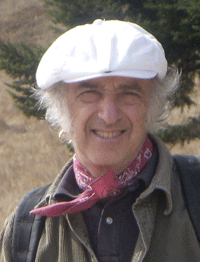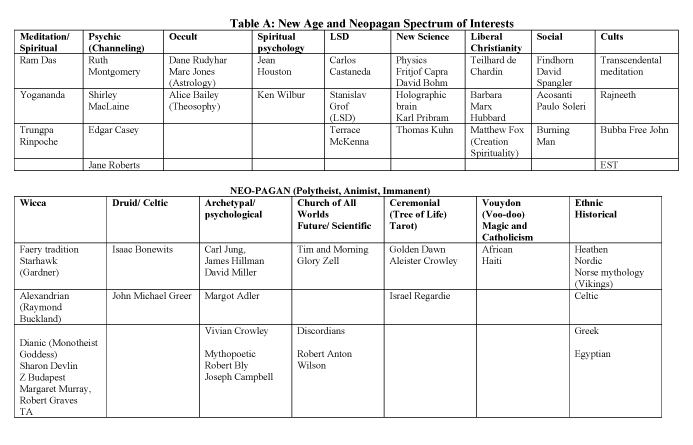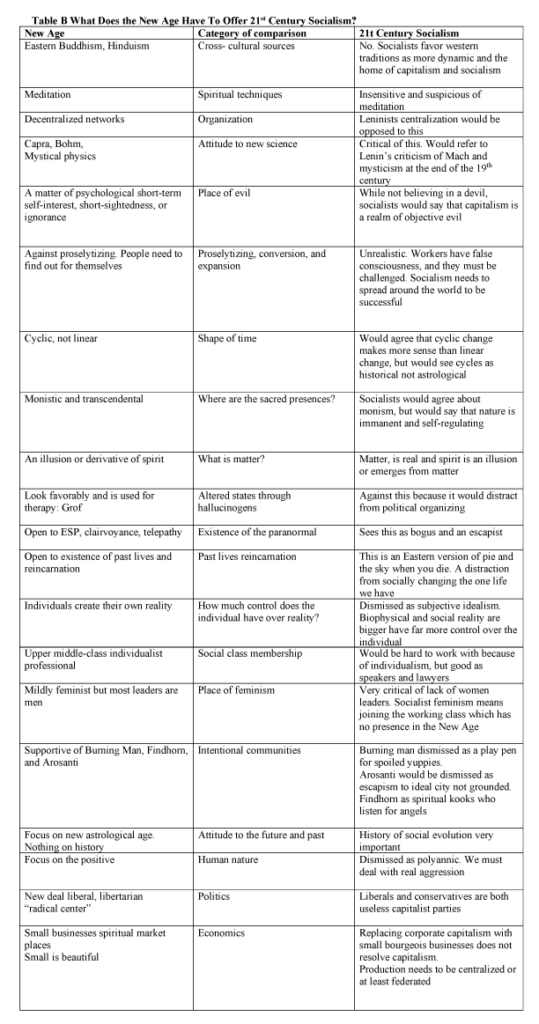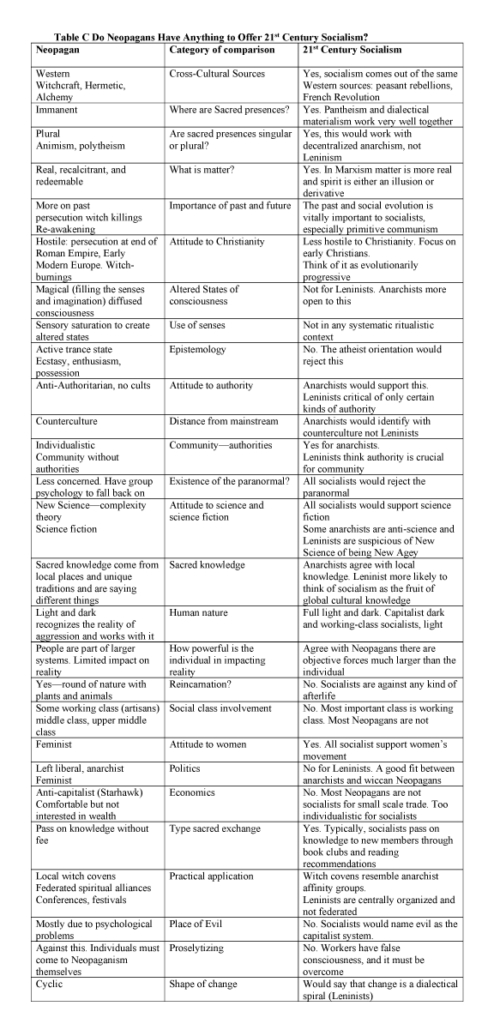NEW AGERS VS NEOPAGANS: CAN EITHER BE SALVAGED FOR SOCIALISM? PART II


By Bruce Lerro, Co-Editor, Planning Beyond Capitalism
Orientation
The term “New Age “means different things to different people: some positive, some negative. But I disagree with those sociologists or scholars of New Religious Movements who are overly inclusive and lump all kinds of alternative movements into New Age. To address this, in Part I of this article I contrasted twenty-seven ways in which Neopagans differ from New Agers. I began with what New Agers have in common. Then I defined the New Age, its boundaries and relationships with other movements along with its heroes and heroines. Then I did the same for Neopaganism. I also identified the historical and economic circumstances in which each arose.
However, my intentions are more ambitious than just doing a compare and contrast exercise. As a socialist, I want to know if either the New Age or Neopagan movements have anything to offer 21st century socialism? If you ask socialists themselves the overwhelming majority say no! They might say New Age is a desperate attempt by alienated middle classes to escape the crisis in capitalism by retreating into mysticism. They might refer to its commonalities with the mysticism of the end of the 19th century that Lenin criticized. As for Neopagans, socialists might say they are a throwback to superstitious times before the Enlightenment. The Enlightenment, after all, dismissed witches as products of the sick minds of the Inquisition. Undeterred by this socialist cynicism, in Part II of this article I answer the questions I raised at the end of Part I. First, I address what New Age has to offer socialism. Then I ask is there anything of value that Neopaganism has to offer socialists. I conclude that there is almost no New Age claims and values that are of any use to socialism. On the other hand, there is quite a bit that Neopaganism has to offer socialism if only socialists would listen.
WHAT DOES THE NEW AGE HAVE TO OFFER SOCIALISM?
Eastern spiritualism and spiritual individualism
Many socialists are insensitive to the difference between the Judeo-Christian religion of the West and Eastern spiritualism, which is embraced by New Agers. They are likely to dismiss the new-found techniques of meditation and rarely meditate themselves. What socialists would particularly reject is the do-it-yourself individualist spirituality. Liberation Theology socialists might say at least Catholic spirituality has a social component. Working-class socialists would either continue with their traditional religions or simply drop out and be apathetic to their religion. Individualist spirituality would have no draw for them.
The new science and decentralized eclecticism
Socialists would happily agree with New Agers who rejected mainstream political and religious authorities, but they are not likely to agree with New Agers about science. For socialists, science is a bedrock and they are likely to be unaware of new science and would not be very interested in challenging tradition. There are some socialists that would celebrate Stephen J. Gould’s punctuated equilibrium as the application of dialectics to Darwinian theory. However, New Age interest in science is usually the New Physics, the study of the brain and states of consciousness. Socialists usually aren’t interested in these subjects. New Age is a decentralized association of groups that have made little, if any, attempt to centralize or coordinate their activities let alone centralize so that they might fight for power. Socialist would see New Age as a spiritual marketplace.
The subjective nature of evil, anti-proselytizing
The New Ager’s Pollyanna attitude of love and light would drive all socialists crazy. While socialists would agree with New Agers that there is no objective evil in the form of a devil, socialists would disagree that evil comes from psychological short-sightedness, lack of education, or ignorance. Socialists would say capitalists are a small class of people that are willing to destroy humanity and the planet. This class struggle is not a matter of capitalists being short-sighted, lost, greedy, or incompetent. Socialists would not call capitalists “evil” because of its moral and spiritual overtones. But this is what it amounts to.
Some socialists would agree that the development of a socialist individual identity would move beyond the individual ego, but would say that deeper individual self is inseparable from the practice of a community of socialists and not to be achieved through an isolated spiritual practice. New Agers reluctance to proselytize or do a kind “missionary” work would be treated as lacking ambition. Socialists want to recruit the working class to its ranks and understands that the working-class has “false-consciousness” that must be overcome through argument and struggle. Socialists know that socialism can only be successful if it can spread internationally. It must aspire to expand. It cannot afford to wait for workers to get on board on their own accord.
The shape of change
Socialists would agree with New Agers that operating with a linear sense of time is outdated. They would agree up to a point with New Agers about the importance of looking at long-term change as cyclic. However, socialists’ interest in cycles would be limited to historical change. It would mock New Age interest in long-term astrological cycles. For socialists, astrology has nothing to do with what happens in history. Lastly, for Marxian socialists, cycles change into a dialectical spiral moving from theses-antithesis and synthesis.
Ancient Wisdom of the East
Is it in some way advantageous for socialists that New Agers draw heavily from Eastern traditions of Buddhism, Hinduism, and Taoism rather than western traditions in Europe? For better or worse, for socialists it would be a disadvantage. Capitalism developed first in the West and working-class opposition to it also derived there. Most socialists still believe that any hopes for socialism will come out of Europe, because there has been a much deeper history of rebellions and revolutions than in the East. The fact that the first socialist revolution (Russia) did not have advanced industry;
The fact that today the largest socialist country in the world (China) is not from the West, should make socialists pause. Unfortunately, many socialists treat Marx’s theory that socialism is most likely to be from industrialized countries dogmatically and will be slow to change.
Where do sacred sources come from: the perennial philosophy
New Agers are critical of organized religion not because the spiritual world doesn’t exist but because organized religion is a bastardized, exoteric version of religion for controlling the masses. For New Agers, at the core of every world religion is an esoteric core of spiritual truths which all the great spiritual founders agreed with. This has been called “the perennial philosophy”. New Agers support the esoteric version of all the world’s religions. What would socialists think of this? They would be happy to see that New Agers are sensitive to the propagandist nature of world religions. The less dogmatically atheists like social democratic socialists might see some value in this.
Transcendentalism, monism, and the reality of matter
New Agers tend to see an ultimate spiritual force as being monistic and transcendental to biophysical and social reality. How might that be received? Socialists will be split on the question of whether the ultimate source is singular or plural. Most Marxists are materialistic monists and they will appreciate all of reality comes from a single source. The anarchists, being decentralists will object and claim this as some form of spiritual imperialism. However, both Marxist and anarchists would be dead set against the sacred source being beyond the world (that is, transcendental). All socialists see nature and society as immanent, self-regulating, and creative. The fact that most New Agers see matter as either an illusion or a derivative of spirit would be dismissed by socialists. Socialists are generally materialists who think that matter is real and spirit is either an illusion or derivative.
Altered states, parapsychology, reincarnation, and creating your own reality
New Agers are greatly drawn to altered states of consciousness, either through mystical experience of through the use of hallucinogens. How will this go over with socialists? Not well. The leaders might think taking mind-altering drugs is a distraction from doing political work. Socialists will roll their eyes at New Age interest in ESP, clairvoyance, and telepathy and claim that a century’s worth of research has not found anything significant. They see this as more New Age escapism. Working-class recruits will find this interesting and would probably enjoy TV shows like The X-files. Some New Agers claim to believe in reincarnation. Some say individuals are working out karma based on past lives. What will this do to socialist organizing? How might it help or hurt a working-class person to know they were a prince or a pauper in another life? Socialists will view belief in reincarnation as more pie in the sky when you die. It is a distraction from the one life we have and it pulls us away from making the world a better place. It reduces our world to a reform school for learning spiritual lessons.
More extreme New Agers like EST or Shirley MacLaine claim that individuals create their own reality and that reality has no objective existence. All socialists would throw up their hands at this and point to Berkeley or Fichte and say this is subjective idealist narcissism. The objective world is prior to, independent of, and beyond subjective reality, and individuals are limited in their aspirations based on their class location, their race, their gender, and the point in history they are born.
Upper-middle class and mildly patriarchal
Demographically New Agers are primarily upper-middle class professionals. This would work against organizing them into socialist organizations or a mass party because upper-middle class people are more individualistic based on the kind of work they do. However, if mobilized, they would be good at public speaking or legally defending socialists. Because some New Agers are susceptible to following Gurus this may work well with Leninist organizations which are sometime cultist (Democratic Workers Party in San Francisco and the Sullivanists in New York, both in the 1980s). New Agers are moderately supportive of feminism. However, many women in New Age cults have been sexually exploited. Socialist feminists would be especially disgusted by this. They would see that women can only gain more power by being part of a movement that includes the working class, which is essentially absent in New Age circles.
Spiritual intentional communities: Burning man, Arcosanti and Findhorn
If a radical socialist labor union were taken on a tour of Findhorn, Soleri’s Arcosanti city, or given admission to a nine-day Burning Man, what would they think? Burning man would be immediately dismissed as a decadent play-pen for spoiled upper-middle class yuppies. Arcosanti would be dismissed as an impractical utopian city which is hopelessly running away from capitalism. Socialist cities have to grow out of a revolutionary struggle, not set up outside of it. Findhorn community would be looked upon as a bunch of spiritual kooks listening to angels.
Please have a look at Table A which lays out the New Age spectrum of interests. Following that, please see Table B which summarizes how New Age beliefs and actions compares with 21st century socialism. Across these 20 categories there is not a single clear commonality. Now we will turn to Neopaganism and see what it has to offer socialists.
What Does Neopaganism Have to Offer Socialism?
Western magic and matter as creative and self-regulating
Paganism and the western ceremonial magical traditions have deep roots in the West, from ancient Roman times through the Renaissance magicians, alchemists, Rosicrucian’s, and up to the Golden Dawn at the end of the 19th century. All these traditions were committed to in some way redeeming matter, rather than dismissing it or warning that it was an illusion. The “low” magical traditions of witchcraft are more controversial in terms of their origins. But we do know that witches were herbalists and midwifes and were committed to working with and transforming matter. Matter was seen by all magical traditions as creative, self-regulating, and immanent in this world. They are either pantheists or polytheists. Like socialist materialists, matter is seen by pagans a real. There is clearly a relationship between pagan pantheism and dialectical materialism.
Nature and society are objectives forces that impact individuals and only groups change reality
Unlike New Agers, Neopagans would never say individuals “create their own reality”. Neopagan nature is revered and must be taken care of. The forces of nature or the gods and goddesses actively do things to disrupt the plans and schemes of individuals. How would socialists react to this? Very positively. All socialists understand nature and society as evolving. Secondly, socialists understand that the individual by ourselves can change little. It is organized groups which change the world. Since much of Neopagan rituals are group rituals, there would be compatibility in outlook here as well.
Embracing the aggressive and dark side of nature and society
Neopagans could never be accused of being fluffy or Pollyannish. They recognize that there is dark side of nature, and as Jung would say, a shadow side of humanity and individuals. These dark forces must be worked with and integrated. Socialists would agree with this, but in so far as the darkest force on this planet is capitalism, socialists would disagree that there can be any integration with capitalism. Since most Neopagans are not radical socialists, they might see socialists as advocating a dualistic cosmology.
Importance of the past and future and the shape of change
As I said in Part I, the past is very important to Neopagans mostly because of what Christianity did to pagans throughout Western history. Socialists might disagree with the value of Christianity. Some socialists focus on early Christianity and think in some ways Christianity was an evolutionary advance from paganism. Regardless of this difference, the past is also very important to Marxists because primitive communism was an example of how humanity could live without capitalism. Neopagans, like Marxists, are also very pro-science (some anarchists are not) and are very interested in science fiction and how society could be better organized in the future.
However, there is a difference in how the shape of change in conceived. Pagans see change as taking place in cycles with the turning of the seasons over the eight pagan holidays of the years as a model. Marxian socialists would say this misses the fact that cycles turn into dialectical spirals, where the past returns on a higher level. This can be seen in Marxist visions of social evolution when primitive communism returns on a higher level to mature communism after mature communism has appropriated the material wealth produced by capitalism.
Neopagans also seem far less interested in the prospects of paranormal psychology than New Agers are. As I said earlier, good pagan rituals create altered states of consciousness on a regular basis and perhaps, they are not looking for something out of the ordinary if the ordinary rituals can achieve altered states. This is one less obstacle for socialists to overcome.
Attitude towards authority, politics and economics
Unlike the New Age, there has never (to my knowledge) been pagan cults. Neopagans are generally an anti-authoritarian lot and organizing them can be like herding cats.
They are also anti-authoritarian in that most are self-educated like most socialists and do not have many “holy books.” Neopagans, like socialists are very anti-capitalist in that they usually do not charge beginners in terms of passing on knowledge. Dedication to learning, sincerity, and consistency are all that is required. Anarchists and Neopagan witches are sympatico on this. Leninists who are hierarchical in their political organization would have difficulty with Neopagan anti-authoritarianism and they would be dismissed as anarchists.
Politically, many wiccan pagans like Starhawk’s Reclaiming have organized themselves anarchistically with consensus decision making, so they would be on a collision course with Leninists. Even worse, Neopagans who are ceremonial magicians organize themselves in graded orders, with knowledge passed on gradually over many years. This hierarchy in the magical world is then projected into politics. There are real reactionaries and even monarchists involved in ceremonial magic. Another point of difference is over whether or not to proselytize and convert. Like New Agers, Neopagans think people have to come to paganism on their own. Socialists disagree with them, as I discussed in our section on the New Age.
The most predictable anti-capitalists in Neopaganism are wiccans. Wiccans are also very pro-feminist and some are organized where the goddess values of women are predominant. All this is good news for socialists since Margot Adler has said that about half of the roughly 200,000 Neopagans are wiccans. The rest of Neopagans are for small business capitalism like running bookstores or coffee shops rather than supporting big business. Neopagans are more diversified class-wise than New Agers. There are some artisans, white collar working-class, middle-class, and those working with computers. These folks have less resistance to being organized with working class people than the prospect of socialists trying to organize with mostly upper middle-class people as in the New Age.
Altered states of consciousness, sensory saturation, gods and goddesses
I have saved these categories for last because this is the area of Neopaganism that might be the most actively contested by socialists, but it is also the area that I think Neopagans have the most to teach socialists. As I’ve stated in other articles, a good definition of magic is the art and science of changing group consciousness at will by saturating the senses through the use of the arts and images in ritual. Socialists are likely to dismiss this as dangerous because it sweeps people away. They are also likely to confuse this with religious rituals which religious authorities use to control their parishioners for the purposes of mystifying people and asserting control over them. This is a big mistake. Not all rituals are superstitious and when done well, they can empower people and build confidence. People in egalitarian societies, the ones Marxists call primitive communism, understood this.
As far as gods and goddesses go, in a superficial way we can say socialists are atheists and Neopagans believe in gods and goddesses, and that’s the end of it. But it is not so simple. Yes, there are Neopagans who believe in the real existence of gods and goddesses (called “hard polytheists”) but these gods and goddesses do not contain the usual attributes of the monotheistic god. They are not transcendental; they do not promote fear and submission, nor do they have unrealistic, one-sided positive attributes such as all loving and all-knowing. These gods and goddesses don’t infantilize the population. Neither is there a devil as in monotheism. In Greek mythology, for example, all the gods and goddesses have strengths and weaknesses, expressing on a larger scale similar problems as human beings. There are no escape hatches for Neopagans.
Secondly, not all Neopagans believe in the independent existence of gods and goddesses. Some follow the Jungians in claiming the gods and goddesses are archetypes of collective humanity. They are projections along with mythology that shows people how to live. Finally, there are those like myself who are Atheopagans. Led by Mark Green, we see gods and goddesses as metaphors for how to live. In their rituals, Neopagan gods and goddesses are not part of the ritual, but the ritual is very powerful without them.
Conclusion
Of the 23 categories I’ve actively compared between Neopaganism and socialism, there are eight categories where there was full agreement between Neopaganism and social democrats, anarchists, and Leninists. The categories include:
- Western sources of influence
- The similarities between pantheism and dialectical materialism
- Matter is active, self-creative, self-regulating, and independent of mind or spirit
- Importance of the future in the form of science fiction
- Recognition and acceptance of the aggressive and dark side of nature and humanity
- Very pro-feminist—emphasis on goddesses in Neopaganism and socialist feminism
- Passing on special knowledge without economic exchange. Importance of self-education
In addition, the political decentralization of the anarchists is directly in line with wiccan covens. This is a direct challenge to any kind of federation or centralization, whether it be Leninists or Social democrats. Given that, according to Margot Adler, about half of Neopagans are wiccans, there is an even stronger connection between anarchism and Neopaganism.
In other articles I’ve named some of the major components of 21st century socialism for Yankeedom. A mass political party which analyzes, generalizes, and spreads working-class self-organization: the presence of newsletters like Labor Notes which tracks working class struggles around Yankeedom; the presence of a transition program which shows workers our plans 3,5, 10 years down the road; the presence of worker cooperatives where workers rehearse how to make decisions about what to produce, how to produce it, and where the product should go as well as how much to pay themselves. Lastly, economic theorists which track the crisis in capitalism and project various alternative socialist economic models. In socialist economics, this would the work of Richard Wolff, David Harvey, Anwar Shaikh, Michael Roberts, and John Bellamy Foster. Since most of these economists are social democrats, they might have some appeal to Neopagan New Deal liberals who might be curious about socialism. The work of anarchist economist David Graeber would be perfect for Neopagan witch anarchists. With the possible exception of a transition program, Neopagans could easily be brought in.
However, where Neopagans have most to offer socialists is their ability to do meaningful rituals during the course of the seasons of the year. There are eight Neopagan holidays throughout the year: Yule (Winter Solstice); Brigid (Candlemas); Eostar (Spring Equinox); Beltane (May Day); Litha (Summer Solstice); Lughnasad; Mabon (Fall Equinox); Samahin (Halloween). People all over the world celebrate some or even all these holidays. The benefit of celebrating these holidays is that it gives a cyclic dimension to social life. It harnesses us to nature and the turning of the seasons.
The history of socialism is out-to-lunch in not understanding the importance of cycles of the seasons to human beings. It is one of many reasons why nationalism, sports, and religion have been more attractive to the working-class than socialism. Sports is rooted in the seasons of the year. For baseball, spring to fall, then next spring and next fall. For football, its fall and winter. Nationalism has its special holidays peppered throughout the year that are connected to the seasons. So does religion. What do socialists have to celebrate seasons? Nothing. Socialists have no yearly rhythm. Strikes, boycotts, and protests all rise in reaction to a particular event. When they are over, there is no grounding in how they might be connected to the spring and summer. There is no socialist respect for the turning of the seasons in nature and that we are partly biological beings who need rituals to ground us in the seasons. As I’ve said in other articles, we need socialists in the arts, especially in dance, music, choreography, and playwriting to join with Neopagans who are already good at this. Socialism badly needs seasonal rituals if it is to compete with sports, nationalism, and religion.
 Bruce Lerro has taught for 25 years as an adjunct college professor of psychology at Golden Gate University, Dominican University and Diablo Valley College. He has applied a Vygotskian socio-historical perspective to his four books: From Earth-Spirits to Sky-Gods: the Socio-ecological Origins of Monotheism, Individualism and Hyper-Abstract Reasoning Power in Eden: The Emergence of Gender Hierarchies in the Ancient World Co-Authored with Christopher Chase-Dunn Social Change: Globalization from the Stone Age to the Present and Lucifer's Labyrinth: Individualism, Hyper-Abstract Thinking and the Process of Becoming Civilized He is also a representational artist specializing in pen-and-ink drawings. Bruce is a libertarian communist and lives in Olympia WA.
Bruce Lerro has taught for 25 years as an adjunct college professor of psychology at Golden Gate University, Dominican University and Diablo Valley College. He has applied a Vygotskian socio-historical perspective to his four books: From Earth-Spirits to Sky-Gods: the Socio-ecological Origins of Monotheism, Individualism and Hyper-Abstract Reasoning Power in Eden: The Emergence of Gender Hierarchies in the Ancient World Co-Authored with Christopher Chase-Dunn Social Change: Globalization from the Stone Age to the Present and Lucifer's Labyrinth: Individualism, Hyper-Abstract Thinking and the Process of Becoming Civilized He is also a representational artist specializing in pen-and-ink drawings. Bruce is a libertarian communist and lives in Olympia WA.The views expressed herein are solely those of the author and may or may not reflect those of The Greanville Post. However, we do think they are important enough to be transmitted to a wider audience.
If you find the above useful, pass it on! Become an "influence multiplier"!
The battle against the Big Lie killing the world will not be won by you just reading this article. It will be won when you pass it on to at least 2 other people, requesting they do the same.
| Did you sign up yet for our FREE bulletin? It's super easy! Sign up to receive our FREE bulletin. Get TGP selections in your mailbox. No obligation of any kind. All addresses secure and never sold or commercialised. [newsletter_form] |
![]()
This work is licensed under a Creative Commons Attribution-NonCommercial 4.0 International License
















